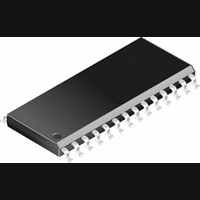LM4834MS National Semiconductor, LM4834MS Datasheet - Page 13

LM4834MS
Manufacturer Part Number
LM4834MS
Description
IC, AUDIO PWR AMP CLASS AB 1.75W SSOP-28
Manufacturer
National Semiconductor
Datasheet
1.LM4834MSNOPB.pdf
(14 pages)
Specifications of LM4834MS
Amplifier Class
AB
No. Of Channels
1
Output Power
1.75W
Supply Voltage Range
4.5V to 5.5V
Load Impedance
8ohm
Operating Temperature Range
-40°C to +85°C
Amplifier Case Style
SSOP
Rohs Compliant
No
Available stocks
Company
Part Number
Manufacturer
Quantity
Price
Part Number:
LM4834MS
Manufacturer:
NS/国半
Quantity:
20 000
Part Number:
LM4834MSX
Manufacturer:
NS/国半
Quantity:
20 000
Application Information
ability to reproduce signals below 100 Hz–150 Hz. In this
case, usinga large input or output capacitor may not in-
crease system performance.
In addition to system cost and size, click and pop perfor-
mance is effected by the size of the input coupling capacitor,
C
reach its quiescent DC voltage (nominally 1/2 V
charge comes from the output through the feedback and is
apt to create pops once the device is enabled. By minimizing
the capacitor size based on necessary low frequency re-
sponse, turn-on pops can be minimized.
CLICK AND POP CIRCUITRY
The LM4834 contains circuitry to minimize turn-on transients
or “click and pops”. In this case, turn-on refers to either
power supply turn-on or the device coming out of shutdown
mode. When the device is turning on, the amplifiers are
internally configured as unity gain buffers. An internal current
source ramps up the voltage of the bypass pin. Both the
inputs and outputs ideally track the voltage at the bypass pin.
The device will remain in buffer mode until the bypass pin
has reached its half supply voltage, 1/2 V
bypass node is stable, the device will become fully opera-
tional.
Although the bypass pin current source cannot be modified,
the size of the bypass capacitor, C
the device turn-on time and the amount of “click and pop”. By
increasing C
However, the trade-off for using a larger bypass capacitor is
an increase in the turn-on time for the device. Reducing C
will decrease turn-on time and increase “click and pop”.
There is a linear relationship between the size of C
turn-on time. Here are some typical turn-on times for differ-
ent values of C
In order to eliminate “click and pop”, all capacitors must be
discharged before turn-on. Rapid on/off switching of the
device or shutdown function may cause the “click and pop”
circuitry to not operate fully, resulting in increased “click and
pop” noise.
In systems where the line out and headphone jack are the
same, the output coupling cap, C
C
load. This desired cutoff frequency will change when the
headphone load is replaced by a high impedance line out
load(powered speakers). The input impedance of head-
phones are typically between 32Ω and 64Ω. Whereas, the
input impedance of powered speakers can vary from 1kΩ
top 100kΩ. As the RC time constant of the load and the
output coupling capacitor increases, the turn off transients
are increased.
To improve click and pop performance in this situation, ex-
ternal resistors R6 and R7 should be added. The recom-
i
O
. A larger input coupling capacitor requires more charge to
is chosen for a desired cutoff frequency with a headphone
B
, the amount of turn-on pop can be reduced.
B
C
0.01 µF
0.1 µF
0.22 µF
0.47 µF
1.0 µF
:
B
T
20 ms
200 ms
420 ms
840 ms
2 sec
ON
O
B
, is of particular concern.
, can be changed to alter
DD
(Continued)
. As soon as the
DD
B
and the
.) This
B
13
mended value for R6 is between 150Ω to 1kΩ. The recom-
mended value for R7 is between 100Ω to 500Ω. To achieve
virtually clickless and popless performance R6 = 150Ω, R7 =
100Ω, C
values of R6 will result in better click and pop performance.
However, it should be understood that lower resistance val-
ues of R6 will increase quiescent current.
LOW FREQUENCY ENHANCEMENT
In some cases a designer may want to improve the low
frequency response of the bridged amplifier. This low fre-
quency boost can be useful in systems where speakers are
housed in small enclosures. A resistor, R
tor, C
back resistor of the bridged amplifier as seen in Figure 5.
At low frequencies the capacitor will be virtually an open
circuit. At high frequencies the capacitor will be virtually a
short circuit. As a result of this, the gain of the bridge ampli-
fier is increased at low frequencies. A first order pole is
formed with a corner frequency at:
The resulting low frequency differential gain of this bridged
amplifier becomes:
With R
order pole is formed with a corner frequency of 120 Hz. At
low frequencies the differential gain will be 4, assuming R
20k. The low frequency boost formulas assume that C
f
IC
, f
OC
FIGURE 4. Resistors for Varying Output Loads
LFE
F
allow the appropriate low frequency response.
FIGURE 5. Low Frequency Enhancement
O
= 20kΩ, R
, in parallel, can be placed in series with the feed-
= 220µF, and C
2(R
LFE
f
c
f
= 1/(2πR
= 20kΩ, and C
+ R
B
LFE
= 0.47µF should be used. Lower
) / R
LFE
C
i
LFE
= A
10001532
LFE
)
vd
LFE
= 0.068 µF, a first
, and a capaci-
10001533
www.national.com
O
, C
S
=
i
,






